Kevin Coote: Olympic Sportsman and Rascal
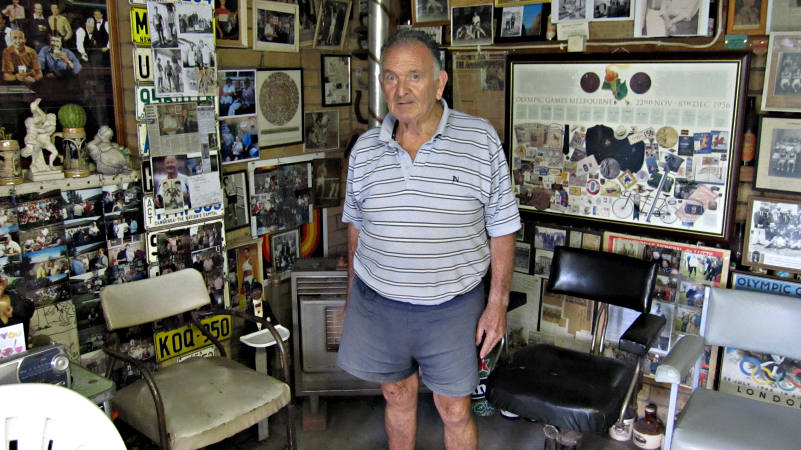
Kevin Coote with some of his treasures, 2009. Courtesy Kingston Collection.
When looking for Kevin Coote you are likely to find him in his garage, amongst a treasure trove of memorabilia. Walls are covered with photographs of wrestlers, boxers, swimmers, bike riders, and footballers, black plastic bags holding autographed flags and shelves with medals from State and National championships, together with medals from British Empire and Commonwealth Games, and Olympic Games. All of these items have a story and a connection to Kevin.
Born at Parkdale on 27 April 1931 to Nellie Margaret Dempster and Roy Browning Coote, his early years were spent with his two brothers, George and Jeff. George the eldest of the three was born in 1929 and Jeff in 1933. Along with his brothers Kevin attended St Patrick’s Primary School in Mentone before moving to Sydney with the family. Kevin’s father had rejoined the navy during the Second World War and was posted to Sydney where he served as a naval diver.
Returning from Sydney Kevin lived for a time with his uncle in Whitehorse Road and attended Box Hill Technical School for one year before returning to the family home at 12 Elm Grove, Parkdale. While at Box Hill he competed in a six mile event along unmade streets and across paddocks, containing all sorts of impediments, in bare feet. Kevin said his feet toughened up while living in Sydney because he rarely wore shoes. In the cross-country race he came second by a small margin to Terry Allan. Allan in later life when asked did he know a Coote he said he went to school with a Kevin Coote and he was ‘bloody mad’. Leaving school, Kevin commenced work as a tiler and later a brick layer.
Kevin was active in sport as a teenager swimming with the Mordialloc Life Saving Club and playing football with Mordialloc. For several football seasons he played with the juniors and had one season with the seniors before retiring from the game. The retirement came about after he was suspended for four matches because of a ‘punch up’ he had with a Cheltenham player on the field during a game at Cheltenham. But the decision was also influenced by a conflict of commitments. The night for football training clashed with a training night for a new interest which took priority. This new interest was wrestling.
The wrestling involvement commenced in a small gym conducted by Bev Scott located in a garage in Bentleigh. After a few months there Kevin was advised to join the Victorian Railways Institute as it had the number one wrestling gym in Victoria. This he did and there he came under the influence of coach Jim Angell. Throughout the normal times of the year he attended two nights a week but during the competitions training intensified, increasing to four sessions a week.
Jim Angell recognized that two of his young wrestlers showed great promise but as they were similar weights they would be competing against each other in the State championship. Therefore, he decided that one would have to compete in a higher weight division. The two wrestlers concerned were Kevin Coote and Bill Davies. To resolve the difficulty they tossed a coin and Kevin lost. As a consequence he wrestled as a heavyweight while Bill Davies competed as a light heavyweight. Despite the weight disadvantage Kevin was successful, winning the Victorian heavyweight title. It was described as an amazing feat for a nineteen year old because to achieve the title he had to win seven bouts to qualify for the final. He was awarded the championship when his opponent who had won the title in the preceding four years failed to put in an appearance. Both Kevin and Bill won their divisions in the Victorian Championships and both went on to contest in the 1951 Australian Championships at Brisbane, although on this occasion they reversed the division in which they wrestled. Kevin, competing as a light heavyweight, was again victorious. Following this success he was selected as a member of the Australian Olympic Team to compete at Helsinki.
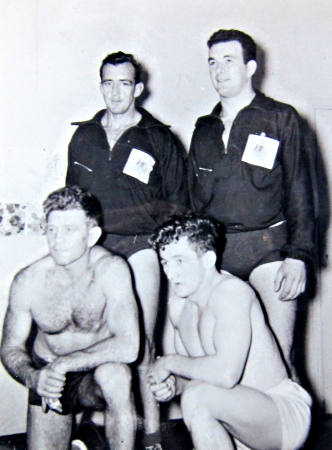
Four Australian Wrestlers, competitors at Helsinki Olympic Games. Front: Dick Garrard and John Elliott. Back: Bev Scott and Kevin Coote. Courtesy: Kevin Coote, Kingston Collection.
At Helsinki Kevin was unfortunate to be matched in his two matches against the eventual gold medal and silver medal winners. However, he was the only wrestler in the whole series to go the full distance with the top two placegetters and emerged from the games without a fall against him. It was while at Helsinki that the decision was made to obtain an Olympic flag as a souvenir of their participation in the Games. Four men, all from Mordialloc, marched in a military manner up to the flag poles outside the stadium and lowered a flag, watched by a crowd of people as though it was a normal event. All members of the Australian team signed the flag which was kept in the wall cavity behind a ventilator screen to avoid detection during room searches by authorities anxious to retrieve it. Other team members attempted to souvenir flags but without success.
After the Games, Kevin joined a Mordialloc friend, Bob McQueen on a Swedish ship on its voyage from Helsinki to Canada. McQueen, and Nobby Clarke also from Mordialloc had worked their passage on the ship from Melbourne to Helsinki where the ship was used as a floating hotel. Kevin signed on as a cook while Bob was a steward. Returning from this journey across the Atlantic Ocean the pair left the ship in France and commenced a short sight-seeing trip around Europe.
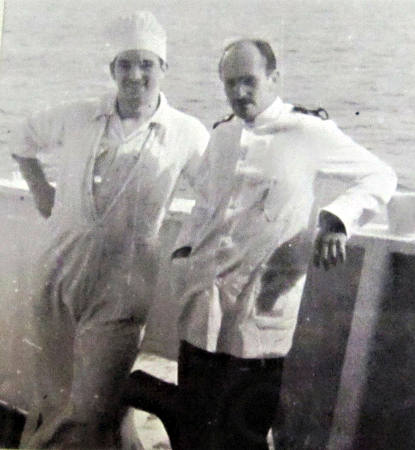
Kevin Coote, cook and Bob McQueen, steward working their way to Canada after Olympic Games in Helsinki. Courtesy Kevin Coote, Kingston Collection.
During this time in Europe Kevin developed a strong friendship with Russell Mockridge who was an outstanding sportsman and cyclist in the Australian Olympic team. At the Games he won two gold medals, the kilo time trial and the tandem, and before the Games he won the prestigious Paris Open Grand Prix. Kevin described Mockridge as ‘The best Australian athlete I’ve ever seen. He was just naturally gifted’ It was while McQueen, Coote and Mockridge were having lunch in a London café and talking about the Grand Prix that Mockridge revealed that he had left the trophy in his hotel room because ‘it was a big heavy thing.’ He told them that he had the winning sash and that was all he wanted. He said they could have the trophy if they wanted to go and pick it up and wrote on the back of the café’s menu a note authorising McQueen to do just that. This McQueen did and carried the cup back to Australia where it was in his care until he died. The cup was then passed to Kevin Coote who in turn passed it in 2008 it to Lindy, Russell Mockridge’s daughter. Leaving Europe and returning to Australia on the Otranto Kevin and Percy Cerutty shared a cabin with Russell. Kevin explained, to burn up their surplus energy they spent time running around the decks and engaging in wrestling bouts
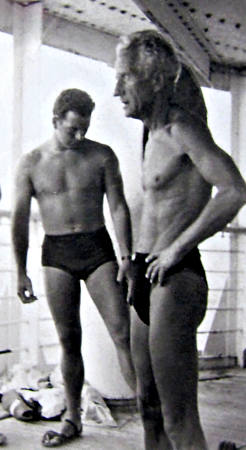
Kevin Coote and Percy Cerutty on the Otranto returning to Australia. Courtesy Kevin Coote, Kingston Collection.
While in London on 9 July 1952 and after the Helsinki Games the Australian team was invited to afternoon tea at Buckingham Palace to meet the Queen. With the team assembled to shake the hand of the Queen, the Duke of Edinburgh and Princess Margaret, Dick Garrard dared Kevin Coote to slide down a banister at the palace. Kevin accepted the challenge sliding about twenty feet. As Kevin said, ‘It wasn’t far and the Queen did not see me.’ Nothing was said about the exploit until four years later. After being told that he was selected for the Australian Olympic team to compete at Melbourne he received a letter from Edgar Tanner, the secretary of the organising committee, informing him he had been banned because of his undisciplined behaviour in London and instructing him to report to the Melbourne Town Hall. ‘There they lifted the ban. I guess the Olympic Committee were trying to frighten me to make me toe the line,’ was Kevin’s comment.
With very short notice the International Wrestling Federation invited Australia to send its best wrestlers to the 1954 World Championships to be held in Tokyo in May. The Japanese paid for travel and forty percent of living expenses while the Australian Association contributed nothing. The additional money had to be raised through local efforts. Fortunately the money was raised and Kevin travelled to Tokyo were he performed well and at the conclusion of the competition was ranked eighth in the world. It was at this competition that Kevin obtained his second flag. At the closing ceremony when the official flag party was lowering a Japanese flag within the stadium Kevin lowered a second flag in unison with the actions of the official party while being watched by Japanese police armed with automatic weapons. ‘There was a certain amount of tension in the situation,’ said Kevin. Later the flag was signed by all wrestlers in the Australian team.
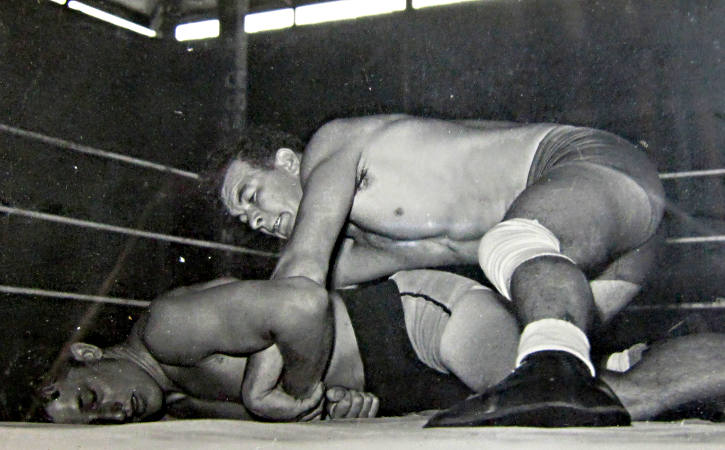
Kevin Coote competing in the Australian Championships 1953, wrestling Fowler of New south Wales. Courtesy Kevin Coote, Kingston Collection.
During a visit to Sakura Nikko Girls’ High School the principal asked that a member of the team speak to the students. Kevin volunteered. Following this engagement he was then invited to take a position as a temporary teacher, teaching conversation English. This he did for two months. At the conclusion of his employment the girls presented him with a navy blue and white kimono, embroided with the traditional motif of a frog jumping into a pond. The gown is a valued item in his memorabilia collection.
Two years later, commencing in November 1956, the Olympic Games were held in Melbourne and Kevin was again in the wrestling team. Sixteen Australian wrestlers took part and of those Kevin was the best performer winning two bouts. In the final rankings he finished equal fifth with a Turkish participant. When asked how his experience at the Melbourne Games compared to Helsinki he replied, ‘The first is always the best.’
One further occasion when Kevin featured in the local press was not related to his prowess as a wrestler. On this occasion he was before the magistrate of the Sandringham Court charged by a constable of the mobile traffic police with speeding, failing to signal his intention of passing another car, only having one headlight and failing to have the tail light of the car switched on while driving his 1937 Ford Coupe along Beach Road. The constable contended that Kevin had passed up to 40 cars without giving the appropriate hand signal when diverting right. This Kevin denied saying he did signal and he had only passed two or three cars. The charge was dismissed. The charges concerning head lights and tail light were admitted by Kevin and he was fined two pounds for each offence. He explained that the mudguards that contained the head lights were at the panel beaters being repaired so he had a fog light in the centre of the radiator. With the tail light he had asked a passenger on leaving the car to switch it on but obvious the passenger failed to do it. However it was with the fourth and most serious charge of speeding at speeds of 55 to 60 miles per hour that Kevin strongly objected. The constable claimed that he had followed Kevin for half a mile maintaining a constant interval between himself and Kevin’s car. In his denial Kevin said it was a Saturday night when he was driving towards Melbourne at the time when traffic was heavy. He believed he was travelling no faster that 40 miles per hour and this was supported by Robert Clark of Mordialloc a passenger in the car. The bench accepted this story and the charge was dismissed.
Today Kevin continues to live in the City of Kingston. After two hip replacements and a body riddled with arthritis, his sporting activity is limited. No doubt this situation has occurred because of the stresses he placed it under in his world class sporting career and working life. Nevertheless he continues to draw upon his memories of an outstanding sporting life as a young man sparked by the mementos he has surrounding him in his mini museum.

Kevin Coote with Lindy, daughter of Russell Mockridge with Grand Prix Cup, c2004. Courtesy Kevin Coote, Kingston Collection.
Footnotes
- See, Graham J Whitehead, George Coote: Reporter and Author, Kingston Historical Website.
- Whitehead, G., Interview with Kevin Coote, 2009.
